Last year, I nearly cried when my brand-new velvet sofa arrived. I’d fallen for its Instagram-worthy curves but forgot one crucial detail: my golden retriever sheds like a snowstorm. That’s when I learned what professional decorators know—beautiful spaces begin with smart planning, not impulse buys.
Let me save you from my fuzzy mistake. Whether you’re refreshing a room or starting fresh, the secret lies in balancing practicality with personality. Ask yourself: How does this area really get used? Do you need kid-friendly fabrics? Extra storage for board games? A cozy reading nook?
We’ll walk through creating a cohesive vision that works for your life. No more buying pieces that clash or gather dust! You’ll learn to mix styles like a pro—maybe coastal accents with mid-century flair? The best part: You can achieve that luxe designer look without blowing your budget.
Ready to make every corner of your home feel intentional? Let’s turn those Pinterest dreams into reality—one smart choice at a time.
Establish a Bold Vision for Your Home
My cousin once bought a farmhouse table that blocked her kitchen doorway for months. Why? She forgot to measure how her family actually moves through the space. That’s why I always start by asking: What story do you want your home to tell?
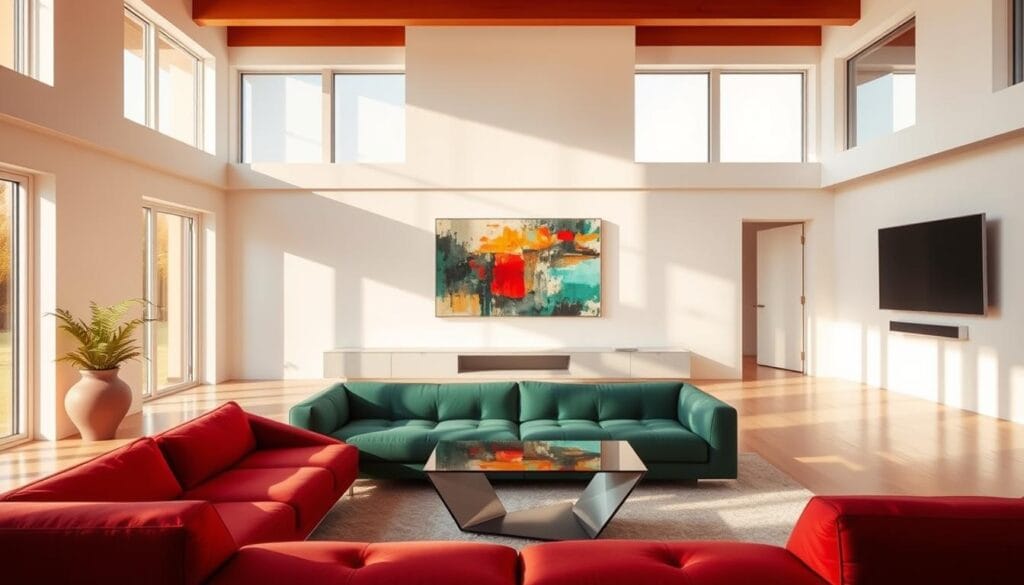
Map Out Your Daily Rhythms
Before picking paint colors or furniture, grab a notebook. Jot down how you really use each room. Need proof? A client transformed her formal dining area into a multi-purpose craft zone after realizing they only ate takeout there. Ask yourself:
- Do movie nights demand comfy floor cushions?
- Would open shelving make breakfast routines smoother?
- Does your entryway need a dog-towel station?
Breathe New Life Into Old Treasures
That chipped dresser from your grandparents? It’s pure gold. Designer Maggie Clarke recently refinished a client’s inherited dining set, swapping reddish stains for soft walnut tones. “Meaningful pieces anchor a space,” she says. Try these refreshes:
- Paint outdated cabinets in moody charcoal
- Swap drawer pulls for modern brass handles
- Reupholster chair seats with textured fabrics
Pro tip: Create a digital mood board using Pinterest snaps of your existing furniture mixed with aspirational images. See what patterns emerge—maybe industrial lighting pairs perfectly with your vintage rug!
Essential Interior Design Tips for a Personalized Space
I once helped a client turn her bland sitting area into a conversation starter using her grandfather’s fishing lures as wall art. That’s when I realized: rooms come alive when they showcase your journey. Forget matching sets from catalogs – let’s craft spaces that feel like chapters from your autobiography.
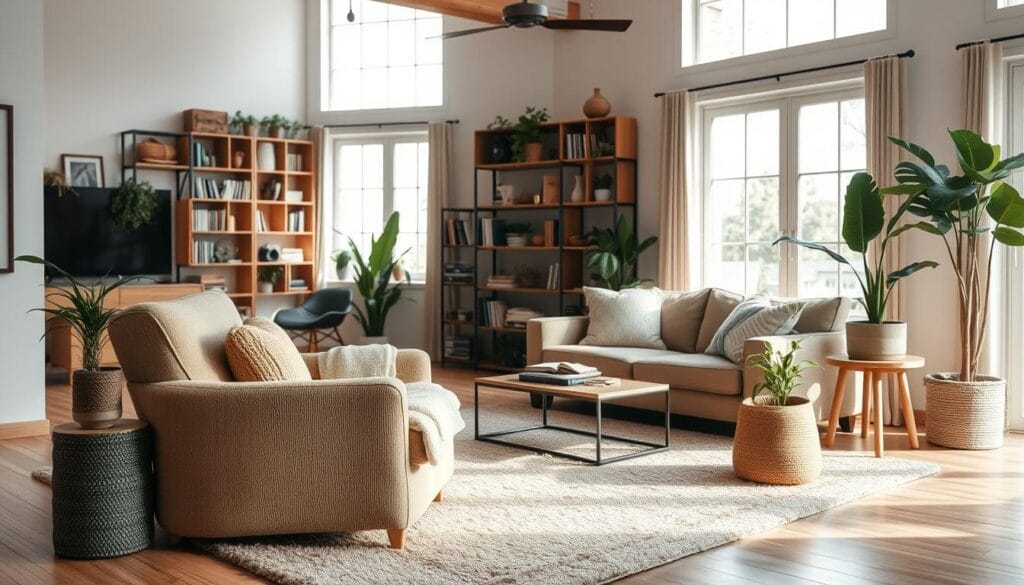
Mix Classic Elements with Modern Flair
Take a cue from designer Amber Lewis’ coastal masterpiece. She paired wave-patterned wall panels with a sleek hidden bar behind a bookcase. Try blending eras with these combos:
- Ornate picture frames housing abstract prints
- Vintage lamps on minimalist side tables
- Traditional crown molding with geometric light fixtures
Add Unique Touches That Reflect Your Story
Your vacation photos deserve better than phone storage. Turn them into a black-and-white gallery wall above built-in shelves displaying travel finds. One client transformed her husband’s guitar picks into drawer pulls – now their bedroom sings with personality.
Start small: Frame children’s doodles as bathroom art. Stencil lyrics from your wedding song above doorways. These whispers of your narrative make guests say “Tell me about this piece!”
Maximize Room Functionality with Smart Layouts
A client recently showed me her “magic trick” kitchen – you’d never guess those elegant shelves hide her blender and pasta maker. This clever approach embodies what I’ve learned: every room deserves a layout that works as hard as you do.
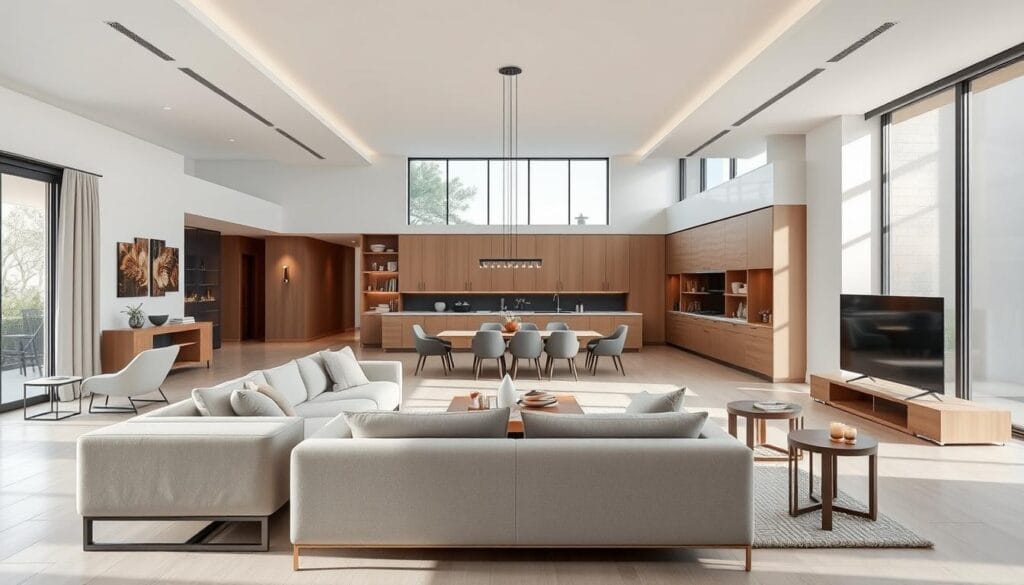
Flow First, Furniture Second
Adam Ben Wagner nailed it when he transformed a kitchen into a library-like space using floor-to-ceiling shelving. His secret? Prioritizing movement. Always leave 36 inches between furniture pieces – enough for two people to pass comfortably. In open-concept areas, use rugs or lighting clusters to define zones without walls.
Seating That Solves Problems
Amber Lewis’ corner banquette taught me seating can be both cozy and space-saving. Built-in benches with lift-up cushions offer hidden storage, while ottomans with trays double as coffee tables. For narrow rooms, try backless stools that tuck completely under countertops.
Don’t overlook vertical real estate! That awkward wall beside your fridge? Perfect for 8-inch-deep spice racks or a fold-down breakfast bar. As we explore in our guide to smart storage solutions, the best layouts make every inch earn its keep – beautifully.
Embrace Color Theory to Enhance Your Room Feel
Last summer, I painted my home office what I thought was a serene blue—until noon hit and it turned into a blinding neon cave. That’s how I learned colors transform with light and intention. Whether you’re craving calm or energy, your paint choices shape how a space lives and breathes.
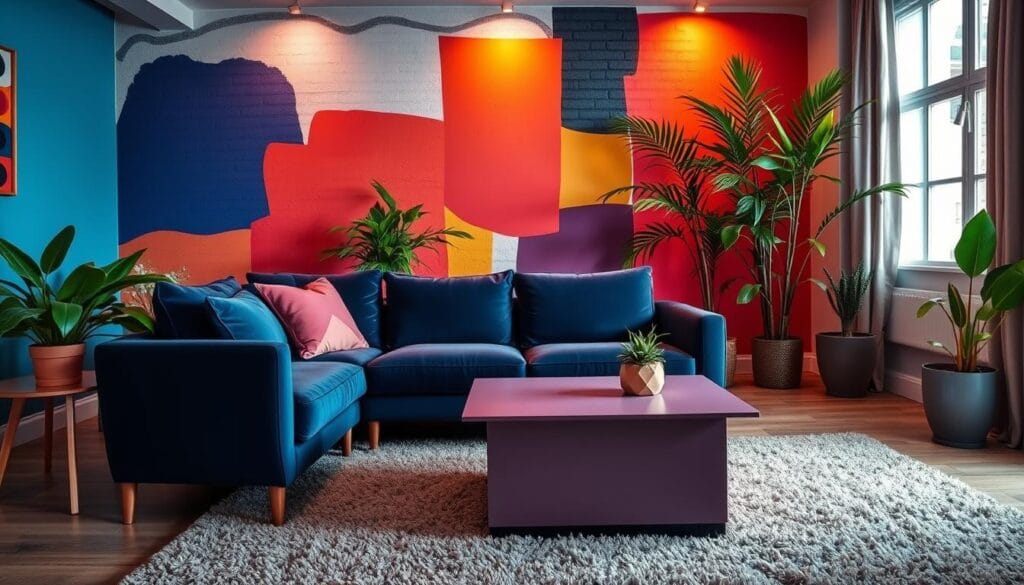
Work With Complementary and Analogous Schemes
Grab a color wheel—it’s your secret weapon. Complementary colors (opposites like blue and orange) create vibrant contrast. For softer harmony, try analogous neighbors like sage and seafoam. A client’s living room apartment ideas came alive when we paired her gray sofa with mustard pillows.
Test swatches at different times! Morning sun warmed my client’s lavender bedroom to periwinkle, while evening shadows deepened it to plum. Natural light plays tricks—always observe samples over 24 hours.
Create Mood With Strategic Paint Choices
Dark walls aren’t just for drama. In a narrow hallway, navy paint receded visually, making the space feel wider. For cozy intimacy in open layouts, try wrapping one wall in rich terracotta.
Remember: Cool tones (blues, greens) soothe, while warm hues (yellows, reds) energize. Balance is key. If your room feel needs adjustment, add contrasting accents through art or textiles. That burst of coral in a teal room? Pure magic.
Pro tip: Paint ceilings pale pink or soft gray to lift the space upward. It’s like giving your room a deep breath of fresh air.
Illuminate Your Space with Creative Lighting
Last month, a client’s kitchen went from feeling disjointed to cohesive overnight—not through remodeling, but strategic lighting placement. Designer Tamara Honey nailed it: “Fixtures should work overtime, blending function with artistry.” Her open-concept space now glows with purpose, proving light shapes how we experience rooms.
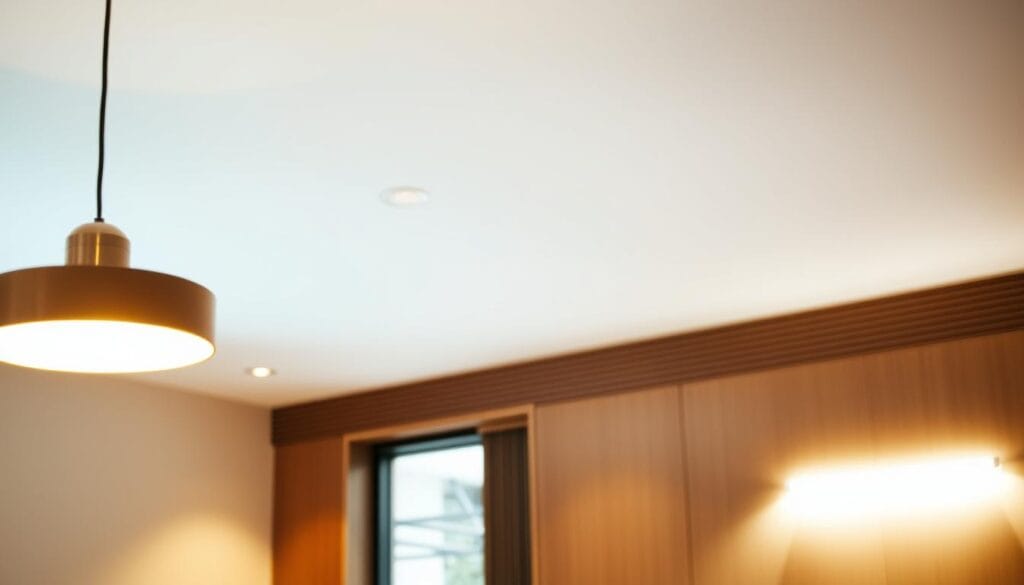
Layer Ambient, Task, and Accent Lighting
Think of lighting like your favorite outfit—it needs layers. Start with ambient sources like recessed lights or chandeliers for overall brightness. Add task lighting where you chop veggies or read. Then, spotlight what you love: shelves, art, or textured walls.
I swear by dimmers—they’re mood magicians. In my own home, we dial down overheads after dinner, letting stylish living room lighting ideas inspire cozy table lamps. This trio of lighting types lets rooms shift from lively to tranquil instantly.
Here’s what works best:
- Pendant lights over islands (keep them 30-36 inches above countertops)
- Adjustable sconces beside beds for late-night reading
- LED strips under cabinets to banish shadowy corners
Proper layers do more than brighten—they expand tight areas and make colors pop. For pro-level tricks, explore this guide to illuminate your space like a designer. Trust me: when light dances across surfaces, even Monday mornings feel brighter.
Curate Furniture That Balances Scale and Comfort
Last winter, a client proudly showed me her new “statement sofa”—only to realize it devoured 80% of her living area. We all want showstopping furniture, but true magic happens when size meets sensibility. The right proportions turn awkward layouts into inviting havens.
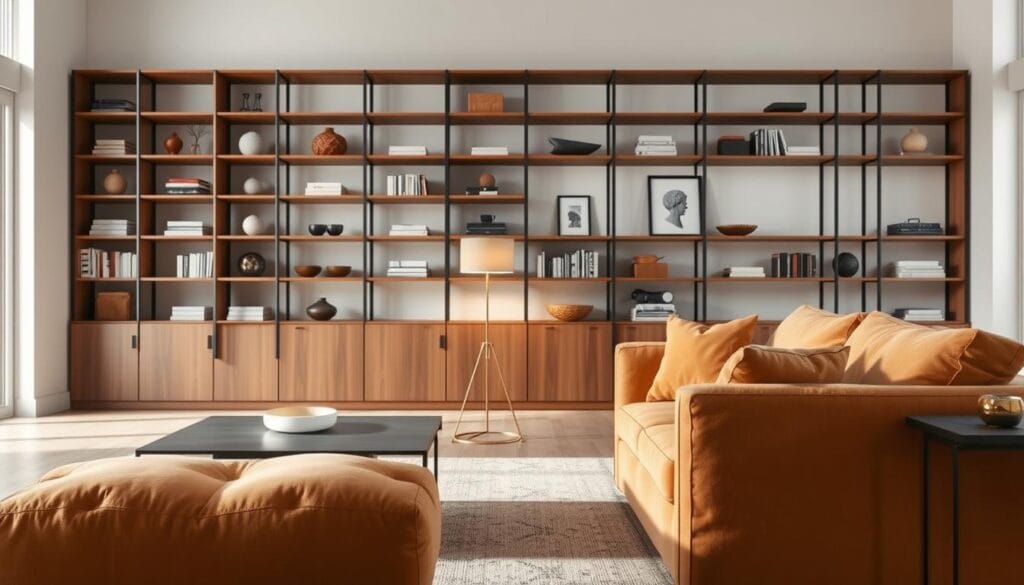
Select Pieces That Suit Room Proportions
Always start with measurements. I use painter’s tape to mark potential furniture footprints on floors and walls. For small rooms, choose slim-arm sofas and nesting tables. Spacious areas? Go bold with a sectional and chunky coffee table.
Ceiling height matters too. Vaulted spaces handle tall bookcases, while standard 8-foot ceilings shine with low-profile media consoles. One client transformed her narrow den using a 72-inch loveseat instead of her dream 96-inch couch. “Now we can actually walk to the balcony!” she laughed.
Mix Functional Seating with Stylish Accents
Your seating should work as hard as you do. I blend plush armchairs with sleek stools that tuck under consoles. Try these combos:
- Deep-seated sofa + velvet ottomans (extra footrests!)
- Wingback chairs + backless bench (perfect for quick sits)
- Built-in window seat + lightweight accent chairs
Leave 36 inches between pieces for easy movement. That cozy reading nook? Even better when you can reach the bookshelf without doing the cha-cha slide. Remember: A well-curated space feels inviting—not like a furniture obstacle course.
Highlight Focal Points with Artwork and Accents
A client once hung a single 8×10 family photo above her massive sectional – it looked like a postage stamp on a billboard. We fixed it with an oversized abstract painting that commands attention while reflecting her love of ocean sunsets. Every room needs this magnetic energy – a visual anchor that tells visitors where to look first.
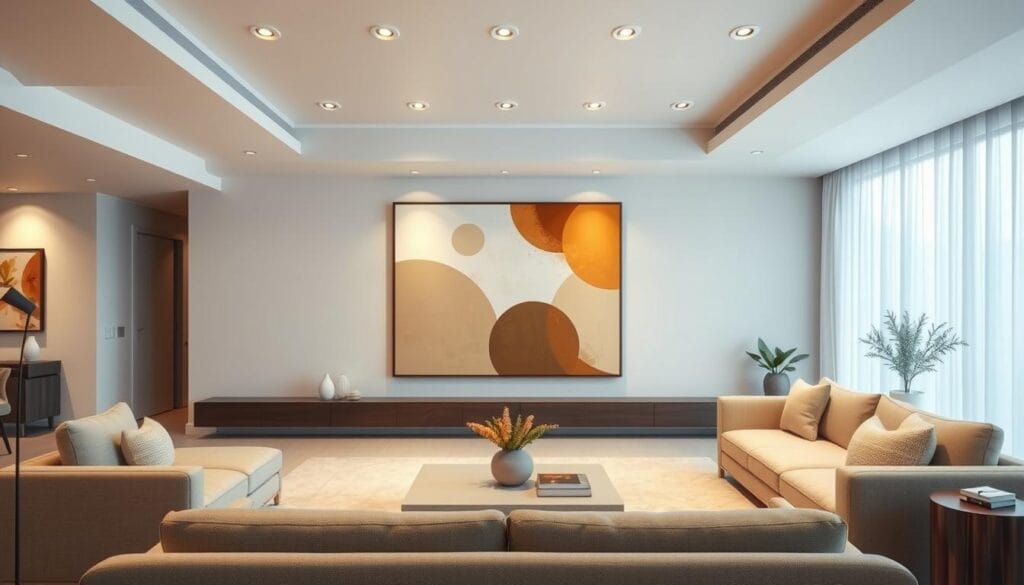
Choose a Standout Centerpiece for Every Room
Your focal piece should spark joy before you arrange anything else. In dining areas, try a cascading chandelier over the table. For modern living room concepts, position your sofa to face a gallery wall layered with framed textiles. Even bathrooms shine with a vanity topped by bold marble veining.
Scale matters most. That 6-foot-wide fireplace? Perfect for stacking art books and ceramic vases. A narrow hallway? Install floating shelves displaying three striking sculptures. Remember: Your eye should land naturally on this area within 3 seconds of entering.
Elevate the Space with Bold Decorative Pieces
Don’t shy away from drama. A client’s bland bedroom transformed when we hung a macramé tapestry behind her bed – suddenly, the whole space felt curated. Try these showstoppers:
- Oversized floor vase with pampas grass
- Antique rug in contrasting colors
- Hand-blown glass pendant light
Layer lighting to spotlight your hero piece. Picture lights above artwork or track lighting angled at your favorite accent wall make details pop. Pro tip: Rotate statement items seasonally – that carved wood screen looks fabulous behind pumpkins in fall!
Design Living Areas for Seamless Flow
I recently visited a house where the kitchen clashed with the dining area so badly it gave me sensory whiplash. Neon bar stools glared at earthy dining chairs, while competing patterns made the space feel chaotic. That’s when I realized: flow matters more than individual pieces.
Designer Colleen Simonds nails it with her approach: “Grounding elements like textured rugs and matte-finish lamps balance busy walls.” In one project, she used a checkered rug to unite clashing patterns—its brown base quieted wild wallpaper while colorful squares added playful energy.
Try these tricks for connected living areas:
- Repeat two accent colors throughout adjacent rooms
- Use similar wood tones in furniture legs and frames
- Align major furniture along shared sightlines
I always sketch how people move through homes. Can you chat with cooks while prepping drinks? Does the coffee table block natural pathways? Arrange seating to create conversation circles, leaving 42-inch walkways. Pro tip: Lay rugs perpendicular to doorways to visually link spaces.
The magic happens when your home feels intentional yet effortless—like your favorite playlist transitioning between songs. No more style whiplash!
Plan Guest-Friendly and Versatile Room Setups
My aunt’s “perfect guest room” had one flaw – visitors kept tripping over the vintage trunk she used as a nightstand. Like her, many of us want welcoming spaces but forget to test them through guests’ eyes. The secret? Rooms should adapt whether you’re hosting book club or out-of-town cousins.
Create Spaces That Welcome Everyone
Take cues from Amber Lewis’ boutique hotel-inspired bathroom. She matched the soaker tub’s blue tones to the adjacent bedroom, creating flow between rooms. Dane Austin’s seating rule works wonders too: “Your living room should accommodate as many people as your dining table.”
I always add these touches:
- Ottomans that serve as extra seating or side tables
- Bedside outlets with built-in USB ports
- Clear pathways (36 inches wide) around furniture
Remember: Great home setups feel effortless. Test your spaces by walking through with a laundry basket – if you bump into walls, rethink the layout. Your people will notice the comfort long before they spot your stylish throw pillows.
